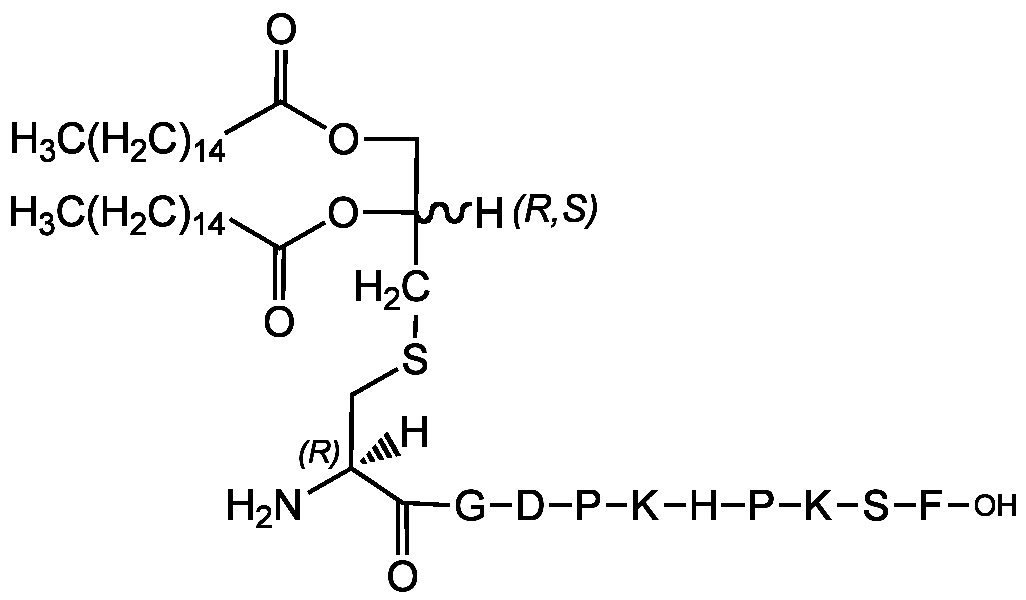
Chemical Structure
FSL-1 [322455-70-9]

AG-CP3-0009
Overview
- SupplierAdipoGen Life Sciences
- Product NameFSL-1 [322455-70-9]
- Delivery Days Customer10
- CAS Number322455-70-9
- CertificationResearch Use Only
- Hazard InformationNon-hazardous
- Molecular FormulaC84H140N14O18S
- Molecular Weight1666.2
- Scientific DescriptionChemical. CAS: 322455-70-9. Formula: C84H140N14O18S. MW: 1666.2. Synthetic. FSL-1 (Pam2CGDPKHPKSF) is a synthetic lipoprotein that represents the N-terminal part of the 44kDa lipoprotein LP44 of Mycoplasma salivarium. Stimulator of TLR2/TLR6. Inducer of TNF-alpha production in macrophages. Upregulates proinflammatory cytokines. Activator of the proinflammatory transcription factor NF-kappaB. - FSL-1 (Pam2CGDPKHPKSF) is a synthetic lipoprotein that represents the N-terminal part of the 44kDa lipoprotein LP44 of Mycoplasma salivarium [1]. FSL-1 is a mixture of R,R and R,S stereoisomers Stimulator of TLR2/TLR6 [2-11]. Inducer of TNF-alpha production in macrophages [4]. Upregulates proinflammatory cytokines [3, 4]. Activator of the proinflammatory transcription factor NF-kappaB [3].
- SMILES[H]C(COC(=O)CCCCCCCCCCCCCCC)(CSC[C@]([H])(N)C(=O)NCC(=O)N[C@@H](CC(O)=O)C(=O)N1CCC[C@H]1C(=O)N[C@@H](CCCCN)C(=O)N[C@@H](CC1=CN=CN1)C(=O)N1CCC[C@H]1C(=O)N[C@@H](CCCCN)C(=O)N[C@@H](CO)C(=O)N[C@@H](CC1=CC=CC=C1)C(O)=O)OC(=O)CCCCCCCCCCCCCCC
- Storage Instruction2°C to 8°C,-20°C
- UNSPSC12352200
References
- The N-terminal lipopeptide of a 44-kDa membrane-bound lipoprotein of Mycoplasma salivarium is responsible for the expression of intercellular adhesion molecule-1 on the cell surface of normal human gingival fibroblasts: K.I. Shibata, et al.; J. Immunol. 165, 6538 (2000)
- Discrimination of bacterial lipoproteins by Toll-like receptor 6: O. Takeuchi, et al.; Int. Immunol. 13, 933 (2001)
- Relationship between structures and biological activities of mycoplasmal diacylated lipopeptides and their recognition by Toll-Like Receptors 2 and 6: T. Okusawa, et al.; Infect. Immun. 72, 1657 (2004)
- Effects of repeated injections of fibroblast-stimulating lipopeptide-1 on fever, formation of cytokines, and on the responsiveness to endotoxin in guinea-pigs: A. Greis, et al.; Acta Physiol. 197, 35 (2009)
- Regulators of G-protein signalling are modulated by bacterial lipopeptides and lipopolysaccharide: S. Riekenberg, et al.; FEBS J. 276, 649 (2009)
- Toll-like receptors and innate immunity: H. Kumar, et al.; BBRC 388, 621 (2009)
- A new cell-based innate immune receptor assay for the examination of receptor activity, ligand specificity, signalling pathways and the detection of pyrogens: A. Burger-Kentischer, et al.; J. Immunol. Methods 358, 93 (2010)
- Toll-like receptor 2 (P631H) mutant impairs membrane internalization and is a dominant negative allele: G.E. Etokebe, et al.; Scand. J. Immunol. 71, 369 (2010)
- TLR2 stimulation drives human naive and effector regulatory T cells into a Th17-like phenotype with reduced suppressive function: M.H. Nyirenda, et al.; J. Immunol. 187, 2278 (2011)
- Activation of endothelial TLR2 by bacterial lipoprotein upregulates proteins specific for the neutrophil response: K. Wilhelmsen, et al.; Innate Immun. 18, 602 (2012)
